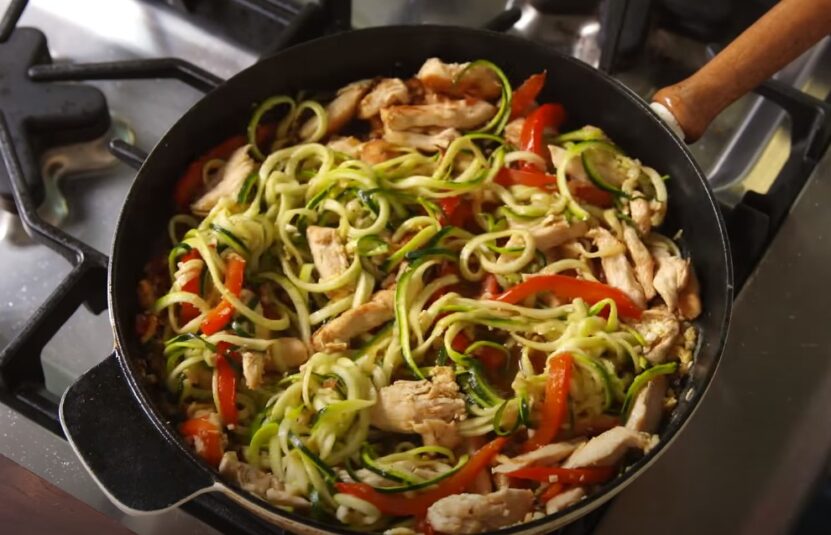Looking for something tasty, filling, AND good for you? Look no more because I just found it – zucchini noodle pad thai! We all know pad thai is one of the most flavor-packed Thai dishes out there. But sometimes the gluten or heavy noodles can be too much.
The zucchini version, on the other hand, really does satisfy cravings while also keeping things light and healthy. Your taste buds won’t even miss the carbs, I swear.
Ingredients you’ll need

- Zucchini: 4 medium-sized zucchinis, spiralized into noodles.
- Protein: Choose from shrimp, chicken, tofu, or a combination.
- Vegetables: Bell peppers, carrots, bean sprouts, and green onions.
- Eggs: 2 large eggs, lightly beaten.
For the sauce
- Tamarind paste: 2 tablespoons.
- Fish sauce: 3 tablespoons
- Soy sauce: 2 tablespoons (use tamari for a gluten-free option)
- Brown sugar: 2 tablespoons
- Lime juice: 1 tablespoon
- Garlic: 3 cloves, minced.
- Red chili flakes: Adjust the amount of chili flakes based on your spice preference to add a subtle or intense kick to the dish.
Garnishes
- Crushed peanuts – for crunch
- Fresh cilantro -chopped
- Lime wedges – for squeezing over the finished dish
How to make the perfect zoodles

Spiralizing the zucchini
Use a spiralizer to turn your zucchini into noodles. If you don’t have a spiralizer, a julienne peeler or a mandoline can work too. Aim for long, even strands. Long, even strands help the zucchini noodles cook evenly and maintain a pleasant texture. Make sure to handle the zucchini gently to avoid breaking the noodles.
Salting and draining
Zucchini has a high water content. To avoid a watery Pad Thai, sprinkle your zoodles with salt and let them sit in a colander for about 20 minutes. This process helps draw out excess moisture. After 20 minutes, gently squeeze the zoodles to remove any remaining water.
This step ensures that your final dish isn’t soggy and helps the zucchini noodles absorb the sauce better. Pat the noodles dry with a paper towel for extra moisture removal.
And now – its majesty, the sauce!

The sauce is the heart of any Pad Thai. Here’s how to make it: In a small bowl, combine tamarind paste, fish sauce, soy sauce, brown sugar, lime juice, minced garlic, and red chili flakes. Stir until the sugar is fully dissolved and the ingredients are well blended.
Make sure to mix thoroughly so that each ingredient is well incorporated. This ensures a consistent flavor throughout the sauce.
Feel free to adjust the flavor
Taste your sauce and adjust as needed. Add more tamarind for tanginess, fish sauce for saltiness, or brown sugar for sweetness. The balance of flavors is key to a great Pad Thai. Don’t be afraid to tweak the proportions to suit your personal taste.
Always keep in mind that the perfect Pad Thai sauce balances sweet, salty, tangy, and spicy elements harmoniously.
Cooking Zucchini Noodle Pad Thai
Now, let’s put everything together:
- Heat a tablespoon of oil in a large pan or wok over medium-high heat.
- Add your chosen protein (shrimp, chicken, or tofu) and cook until done.
- Remove from the pan and set aside. Make sure the protein is cooked through but not overdone, as it will continue to cook slightly when added back to the pan later. This step ensures your protein is juicy and flavorful.
Cooking the vegetables
In the same pan, add a bit more oil if needed, then stir-fry the bell peppers and carrots until they start to soften. Add the bean sprouts and green onions and cook for another 2 minutes. Stir-frying the vegetables at high heat helps to preserve their color and crunch. This keeps the dish vibrant and texturally interesting.
Combine everything
Push the vegetables to the side of the pan and pour in the beaten eggs. Scramble them until just set, then mix them with the vegetables. Add the cooked protein back into the pan. Ensure the eggs are well scrambled but not overcooked to maintain a soft texture.
Add the zoodles
Add the zucchini noodles to the pan and pour the sauce over everything. Toss gently to combine, ensuring the zoodles are well coated with the sauce. Cook for 2-3 minutes until the zoodles are just tender but not mushy.
Be careful not to overcook the zucchini noodles, as they can become too soft. The goal is to have tender yet slightly crunchy noodles that hold up well with the sauce.
Final touches
Serve your Zucchini Noodle Pad Thai immediately, garnished with crushed peanuts, fresh cilantro, and lime wedges. Enjoy!
Tips and tricks

Use fresh zucchini
Fresh, firm zucchinis work best for making noodles. They hold their shape better and have a more pleasant texture. Avoid zucchinis that are soft or have blemishes, as they may not spiralize well or could turn mushy during cooking.
Mix the protein
Feel free to mix and match proteins based on your preferences. Shrimp, chicken, and tofu all work well in this dish. You can also use a combination of proteins for added variety.
Make the sauce ahead
Prepare the Pad Thai sauce in advance and store it in the refrigerator. This makes the cooking process quicker and more efficient. Having the sauce ready to go also allows the flavors to meld together, enhancing the overall taste of the dish.
Add crunch with fresh vegetables
Incorporate a variety of fresh vegetables to add texture and nutrients to your Pad Thai. Bell peppers, carrots, and bean sprouts are great options but feel free to experiment with others. Adding vegetables like snap peas or broccoli can provide additional flavors and nutrients.
You should also try…

Spicy Pad Thai
If you love spicy food, increase the amount of red chili flakes or add fresh Thai chilies to the dish. You can also serve it with a side of sriracha or chili sauce for an extra kick. Adjusting the spice level allows you to tailor the dish to your heat preference, making it as mild or as fiery as you like.
Peanut Butter Pad Thai
For a creamier version, add a tablespoon of peanut butter to the sauce. This gives the dish a rich, nutty flavor that pairs beautifully with the zoodles and other ingredients. The addition of peanut butter also enhances the dish’s protein content and adds a unique twist to the traditional recipe.
Final words
We all know I’m always looking for lighter dishes that don’t skimp on flavor. And this one totally fits the bill – all the bright, vibrant Thai flavors you love without the heavy carbs or gluten. Even better, it comes together so easily. This recipe is definitely becoming a new favorite of mine. After that, we recommend this gluten-free blueberry muffin.

Hi there, I’m Sophie, 35, and I love to cook and experiment with new recipes. It’s my secret sauce for keeping my hubby and three kiddos smiling and our home filled with joy. Cooking is my way of saying, “I love you,” and seeing my family happy and healthy is the best reward.





